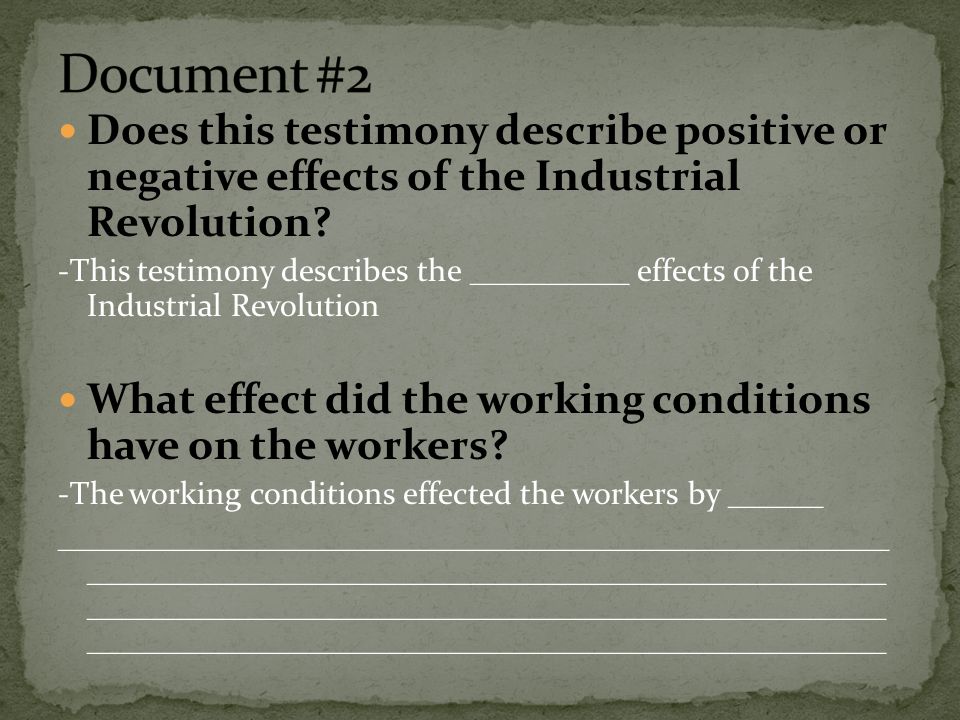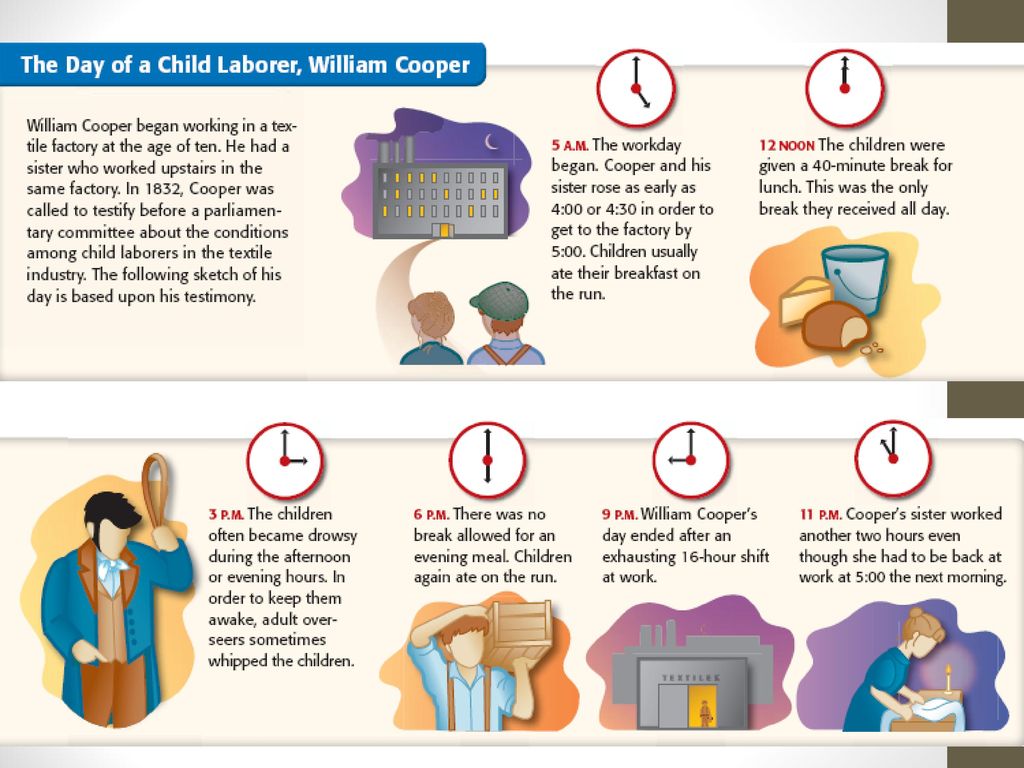Describe Work Conditions in the Factory Based on the Testimony
The basic act was as follows. When I was ten years of age.
How did the Industrial Revolution affect children working in the mills.

. Up to 24 cash back by Michael Sadler investigated working conditions in factories and mills. The committee led by Michael Sadler investigated working conditions in factories and mills. Enclosing or fencing together all of a farmers land began during the 16th century with the mutual agreement of the landowners.
In reality there were no regular hours masters and managers did with us as they liked. Labor unions working conditions pay 12 hour days 6 day work week 3-12 per week wages Child Labor All in family expected to work to make ends meet Weekly cost of living - 1850 Progressive Era Investigations Web page of The United State Department of Labor. He works in the factory for about eight hours.
It is of course one of honest labour. The average worker completed the same task over and over for at least 10 hours a day. During economic recessions many workers lost their jobs or faced sharp pay cuts.
No child workers under nine years of age. This Revolution impacted American lives because it caused factory workers to be treated in an unfair way and were forced to work in very dangerous areas where it was unfit to live inNot only that but they were forced to work for brutal hours days on days but were not payed enough to mirror it PART A Document 1 The following is an excerpt from William Coopers testimony. During the Industrial Revolution it was common for children to work in factories mines and other industrial occupations.
Document 2 The following is an excerpt from the testimony of textile worker Joseph Hebergam to the Sadler Committee. Describe work conditions in the factory based on the testimony. This testimony describes the negative effects of the Industrial Revolution.
The committee led by Michael Sadler investigated working conditions in factories and mills. What effect did the working conditions have on the workers. Consequences of the IndustrialRevolution Adapted from Document-Based Assessment for Global History Historical Context.
This excerpt is from The Philosophy of Manufacturers by Andrew Ure 1835. In 1780 Richard Arkwright built the first steam powered cotton mill. The following is an excerpt from William Coopers testimony before the Sadler Committee in 1832.
Up to 24 cash back The following is an excerpt from William Coopers testimony before the Sadler Committee in 1832. These were caused by all the dust in the factories and the unsafe machines. Describe work conditions in the factory based on the testimony.
The reason there were no guards or protection on the machines was 200 years ago there was no law for health and safetyThe cotton industries were the first to become factory based. Describe work conditions in the factory based on the testimony. There is a break in work in the afternoon for.
He starts for the factory and reaches there on time. The Industrial Revolution which began in England in the late 1700s had a wide range of positive and negative effects on the economic and social life of the people of EnglandThese results have been interpreted from a variety of perspectivesthe. In the 60 years after this cotton factories rose dramatically from zero to 61.
How did the Industrial Revolution affect children working in the mills. -Industrialization effected children working in the factory by _____. Up to 24 cash back The following is an excerpt from William Coopers testimony before the Sadler Committee in 1832.
The effects of working conditions on the workers were damages to the body like the lungs legs and even death. Based on the photograph above describe the work conditions for factory employees. I have damaged lungs.
The term working conditions is not mentioned as such in 2030 Declaration and its SDGs but many related aspects are covered under various goals and targets. Working long hours six days per week contributed to extreme fatigue illness and even injury. Terms in this set 4 inspection.
After having breakfast he begins preparing for his work. I am eight and twenty. The life of the factory worker is hard and difficult.
SDG target 54 specifically addresses the plight of domestic and care workers. Children as young as four commonly worked. The factory worker gets up early in the morning.
When did you first begin to work in the mills. What is the nature of your illnessHebergam. First of all the children could not go to school.
Does this testimony describe positive or negative effects of the Industrial Revolution. Describe work conditions in the factory based on the testimony. Describe work conditions in the factory based on the testimony.
Work in the factories was long and monotonous. The following is an excerpt from the testimony of textile worker Joseph Hebergam to the Sadler Committee. The Industrial Revolution began in Great Britain and quickly spread.
The Industrial Revolution was a period of major industrialization and innovation during the late 1700s and early 1800s. What is your age. Employers must have an age certificate for their child workers.
Though this was known amongst the hands we were afraid to speak and a workman then was afraid to carry a watch. Kids would often die. Describe the effects of industrialization on children working in the factory.
SDG target 85 calls for equal pay for work of equal value and 88 calls for safe and secure working. Jlkjf Describe work conditions in. The clocks in the factories were often put forward in the morning and back at night.
How did the Industrial Revolution affect children working in the mills. Does this testimony describe positive or negative effects of the Industrial Revolution-This testimony describes the _____ effects of the Industrial Revolution. Second of all they had.
The committee led by Michael Sadler investigated working conditions in factories and mills. Children often worked even longer hours -- those who lived at the factory worked up to 18 hours a day. Describe work conditions in the factory based on the testimony.
Factory workers had to face long hours poor working conditions and job instability. How did the Industrial Revolution affect children working in the mills. Young children were working very long hours in workplaces where conditions were often terrible.
Describe the effects of industrialization on children working in the factory. In 1833 the Government passed a Factory Act to improve conditions for children working in factories. During the 18th century enclosures were regulated by.
I have visited many factories both in Manchester and in the surrounding districts and I never saw a. Working on dangerous machinery had its consequences as many children were injured in. New employees found the discipline and regulation of factory work to be very different from other types of work.
Unit Topic And Rationale Amy Samar Teaching Portfolio

Aim How Do We Write A Dbq Essay On The Industrial Revolution Ppt Video Online Download

Dbq Tier 1 Docx Document 1 Does This Testimony Describe Positive Or Negative Effects Of The Industrial Revolution Negative He Was Working For Course Hero

Industrial Rev Pdf Dbq The Industrial Revolution Historical Background The Industrial Revolution Began In England In The Mid 1700 S And Reached The Course Hero

The Industrial Revolution Ppt Download

17 1 Document 17 1 1 Child Labor Was Nothing New For Children Had Long Worked In The Fields And Workshops Of Preindustrial Europe What Was Course Hero

Chapter 17 Primary Sources Hist102 99346 Online 7 12 21 8 08 21 Chapter 17 Primary Sources Studocu

The Industrial Revolution Ppt Download

Pdf Eyewitness Testimony In Occupational Accident Investigations Towards A Research Agenda Psychology Law And The Workplace Editor Margaret Bull Kovera

Industrialization Chapter Ppt Download

Dbq Tier 1 Docx Document 1 Does This Testimony Describe Positive Or Negative Effects Of The Industrial Revolution Negative He Was Working For Course Hero

Industrial Rev Dbq 2 Use 3 Docx Dbq The Industrial Revolution Historical Background The Industrial Revolution Began In England In The Mid 1700 S Course Hero

Industrialrevolution Dbq 2 Docx Dbq The Industrial Revolution Historical Background The Industrial Revolution Began In England In The Mid 1700 S And Course Hero

Industrial Revolution Dbq Docx Document 1 The Following Is An Excerpt From William Cooper S Testimony Before The Sadler Committee In 1832 Sadler Course Hero

Pdf Work Place Environment In Garment Industry An Opinion Survey Of The Garment Worker

Comments
Post a Comment